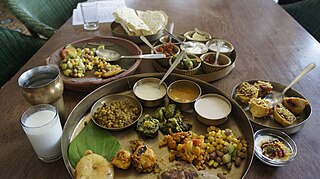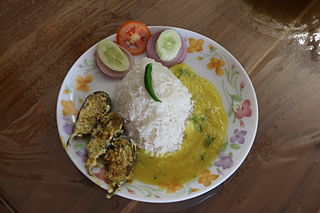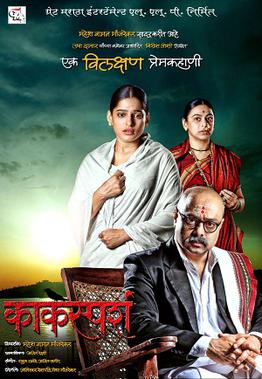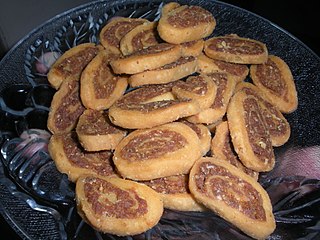Indian cuisine consists of a variety of regional and traditional cuisines native to the Indian subcontinent. Given the diversity in soil, climate, culture, ethnic groups, and occupations, these cuisines vary substantially and use locally available spices, herbs, vegetables, and fruits.

Rajasthani cuisine is the traditional cuisine of the Rajasthan state in north-west India. It was influenced by various factors like the warlike lifestyles of its inhabitants, the availability of ingredients in an arid region and by Hindu temple traditions of sampradayas like Pushtimarg and Ramanandi. Food that could last for several days and could be eaten without heating was preferred.
Malvani cuisine is the standard cuisine of the South Konkan region of the Indian states of Maharashtra and Goa. Although Malvani cuisine is predominantly non-vegetarian, there are many vegetarian dishes. Although it is an independent cuisine, it overlaps Maharashtrian cuisine and Goan cuisine. Malvan is a town in the Sindhudurg district on the west coast of Maharashtra.

Puran poli is an Indian sweet flatbread that is popular in South India and the state of Maharashtra. It is also known as puran puri, holige, obbattu, bobbatlu, poley, bakshamulu, and boli.
Maharashtrian or Marathicuisine is the cuisine of the Marathi people from the Indian state of Maharashtra. It has distinctive attributes, while sharing much with other Indian cuisines. Traditionally, Maharashtrians have considered their food to be more austere than others.

Gujarati cuisine is the cuisine of the Indian state of Gujarat. The typical Gujarati thali consists of rotli, dal or curry, rice, and shaak. The thali will also include preparations made from pulses or whole beans such as moong, black eyed beans etc., a snack item (farsaan) like dhokla, pathra, samosa, fafda, etc. and a sweet (mishthaan) like mohanthal, jalebi, sevaiya etc.

Dāl bhāt (Nepali: दाल भात, Hindi: दाल भात, Bengali: ডাল ভাত, Gujarati: દાળ ભાત, Marathi: डाळ भात, Assamese: দাইল ভাত dāil bhat / দালি ভাত dāli bhāt, is a traditional meal from the Indian subcontinent. It consists of steamed rice and a stew of lentils or other pulses called dal. It is a staple food in these countries. Bhāt or chāwal means "boiled rice" in a number of Indo-Aryan languages.

Thalipeeth is a savoury multi-grain flatbread popular in Western India, particularly in the state of Maharashtra. The flour for thalipeeth, called bhajanee, is prepared from roasted grains, legumes and spices. The ingredients include grains such as rice, wheat, bajra, and jowar; legumes such as chana, and urad; and spices, most commonly coriander and cumin seeds. When preparing the dough, other ingredients such as onion, fresh coriander, other vegetables and spices are added. Thalipeeth is usually served with butter, ghee, or yogurt. The dish is popular in Maharashtra, Telangana and North Karnataka.

Spiced rice is a rice-based dish flavored with various types of spice. Spiced rice is common around the world, with one of the most notable dishes being Indian Ghee rice, which uses ghee butter as a primary ingredient.
Hyderabadi cuisine, also known as Deccani cuisine, is the cooking style characteristic of the city of Hyderabad and its surrounding area in Telangana, India.
Konkani cuisine is the cuisine of the Saraswat Brahmins from the Konkan region on the western coast of India. Konkani cuisine differs within the Saraswat Brahmin subsects and within the Konkan-Canara region. Konkani cuisine originally hails from the Konkan region including Uttara Kannada, Udupi district, Dakshina Kannada, Damaon, and Goa, India. Konkani cuisine is popular served in many restaurants throughout the western coast of India, and especially in the cities of Bombay and Bangalore. Each variation has its unique flavour and makes uses of different vegetables and fruits available in the region. Konkani cuisine is usually pesco-vegetarian, except acharyas and purohits who follow a strictly saatvik vegetarian diet. According the Konkani folklore, fish, meats are regarded as sea vegetables. Historically, they have refrained from eating any terrestrial animals in general.
Goan cuisine consists of regional foods popular in Goa, an Indian state located along India's west coast on the shore of the Arabian Sea. Rice, seafood, coconut, vegetables, meat, bread, pork and local spices are some of the main ingredients in Goan cuisine. Use of kokum and vinegar is another distinct feature. Goan food is considered incomplete without fish.
Vishwanath Vaman Bapat, also known as Vasant Bapat, was a Marathi poet from Maharashtra, India.

Ghugni or guguni is a dish made of peas or chickpeas in Nepal, India and Bangladesh. Different variations of the dish use different types of peas or chickpeas, such as black gram, green peas, or white peas. It is usually eaten for breakfast with toasted bread or puri but can also be served as the main course for lunch or dinner. It can be made either with or without the use of onion and garlic. It is a curry native to the Indian subcontinent.

A tomato omelette is a breakfast dish prepared mostly in Maharashtra, India. It is referred to as an omelette because of its visual appearance, but this is a misnomer, as it actually contains no egg product or by-product and is vegan. The main ingredient is chickpea flour or besan. Sometimes, it is also made with dosa batter, with a small quantity of besan only to provide binding, in which case it is classified as Uttapam.

Kaksparsh is a 2012 Indian Marathi period drama film directed by Mahesh Manjrekar and produced by Aniruddha Deshpande and Medha Manjrekar. The film stars Sachin Khedekar, Priya Bapat, Medha Manjrekar, Savita Malpekar and Ketaki Mategaonkar. Based on a short story by Usha Datar by the same name, the film depicts the tumultuous events in a Chitpavan Brahmin family, set around 1930–1950 in Konkan. The film was a commercial success and got critical acclaim for its direction, screenplay by Girish Joshi and also for the performances by its actors, especially Khedekar for his portrayal of Hari Damle as a head of the family.

Umesh Kamat is an Indian actor and model, who predominantly works in Marathi-language regional films, television series, plays and TV commercials. Kamat has been recipient of Maharashtra State Film Awards for film Samar - Ek Sangharsh.

Daal dhokli is an Indian dish common in Rajasthani and Gujarati cuisine, made by boiling wheat flour pieces in a toor dal stew. A similar preparation is called varanfal, or chakolyaa in Marathi. It is commonly pronounced Dar Dhori in Gujurati. In some household traditions it is made out of leftover dal.

Sai bhaji is a Sindhi vegetarian curry, consisting of dal (lentils), palak (spinach) and other vegetables. It forms a staple part of the local cuisine and is considered a rich source of nutrition due to its mix of various greens.

Bakarwadi is a traditional crispy, deep-fried, disc-shaped, sweet and spicy snack popular in the western state of Maharashtra and Gujarat in India. It was already popular before 1960 when these were not Gujarat or Maharashtra states; they were both a part of Bombay State, and both cultures added their own flavors to each other's recipes.













